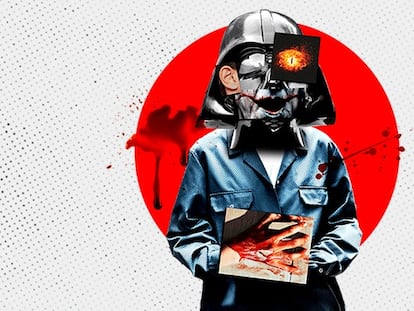‘Ripley,’ or the best treatment of the Patricia Highsmith classic that delves into the cursed human condition
Steven Zaillian has created a more-than-brilliant, profound and post-canonical adaptation of the story of the villain who reinvented the very concept of the villain
When faced with another adaptation of Tom Ripley, the character, the very human villain created by Patricia Highsmith, the writer who tried to understand the evil that nests in each one of us, one wonders what was the need for it? I mean, hadn’t Anthony Minghella nailed the idea of such a charming, queer criminal in The Talented Mr. Ripley, a luminously dark film that became an instant classic in the 1990s? You might ask if the present is so lacking in ideas. But let me tell you that it suffices to watch a few minutes of Steven Zaillian’s Netflix miniseries Ripley to think quite the opposite (Zaillian is also the creator of The Night Of). That is, one wonders why hadn’t anyone done this before, how Minghella could have stayed so far away, so much on the surface of the character, really?
The feeling that, from the beginning, Ripley has been much more than an apparently seductive guy, that he actually never was — for Highsmith, he was always a strange guy — who nevertheless managed to make others trust him because, by observing them, he gave them exactly what they wanted, at all times. What they wanted was attention, to feel understood. The sense that through Ripley the world and the human being — everything that someone is capable of doing to get what he wants, and what he wants is not necessarily a good thing, you will see why — can be explained and has been there from the beginning, but it would seem that what we knew about him was that he was a fake, a trickster, a perpetual mask. And why, how did he experience that mask, where did he leave the rest? Well, Zaillian answers all those questions one by one and raises a few more.
And Ripley does so thanks to a hypnotic and fascinating narration that brings back the best film noir, inhabited by a present in which subjectivity reigns. Thus, there is an excellent intention in the use of black and white — and not only because of the classic air it gives, the tribute to noir from high neo-noir — because there is no color in Ripley’s world, everything is governed by Good and Evil, and the nuance is painful because no one in the society of the time (1961) is seeing it. And it is also there in the third person who constantly becomes the first person — that is, the viewer is both outside and inside the character, because what he is seeing is not only what is happening, but how Ripley himself feels what is happening. And how does Zaillian achieve this? With the sublime use of sound and fixed shots, objects and an environment that only seems to stalk the protagonist. The calm before any storm.

The way the crimes are told is the best example of that latent — and immersive — subjectivity that achieves what Highsmith set out to do, time and again, in her novels by telling how darkness, the damned, nestles in each of us: to empathize. They know the story. The writer’s recently divorced mother drinks a full glass of turpentine when she finds out that she is pregnant. And yet little Pat survives. And she grows up to become a writer who wants nothing more than to understand what her mother did. Her mother must have loved her; but she tried to get rid of her: did that make her horrible? It was through villains who were nothing more than ordinary guys with one foot on the edge of the abyss that Highsmith tried to understand her mother. And Ripley, her most perfect, her most polished, creation.
Remember the story. Tom Ripley (here, Norman Bates-like, played by Andrew Scott with a coyly sinister touch) is a small-time con man who lives by intercepting mail that isn’t his and forging identities to collect small sums. He is hired by a shipping magnate to bring his wayward son, Dickie Greenleaf (a magnetic and superb Johnny Flynn) home. Dickie lives in Atrani, a small Italian seaside town, with his girlfriend Marge (played by a cold and suspicious Dakota Fanning), where the two lead a small bohemian life. Ripley and Dickie are supposed to have been friends at some point — Dickie doesn’t remember him — and the attempt to convince him will turn into an impossible impersonation that Ripley painstakingly improvises as he goes along, criminally eliminating one obstacle after another.
On screen, the subtlety with which Zaillian portrays the fine line that separates Good from Evil — or what we should not have done from what we have done — is drawn by the narrative’s attention to detail and symbols. There’s a narrative beneath the narrative we’re contemplating, which Minghella overlooked; here, they give the character abysmal depth. Those stairs that Ripley climbs, which are at first intricate, labyrinthine, and then cease to be so; they remind us of Sisyphus, in his repeated ascent, the effort, the awareness of the Evil that weighs heavier and heavier. The annoying, insidious clock that marks the race against time that we will never win. The oppressive silence. The silence of death. Ripley is alone with himself when he kills, and the viewer is inside him.
“Tom Ripley is nobody, and so he can be anybody,” Patricia Highsmith herself said of her character. “In that sense, he’s an impostor. He’s someone who gets under someone else’s skin, and so he reflects us a little bit because we’re all a mask in a way,” she added. Yes, Tom Ripley is a mask. He is an animal destined to be someone else, who survives by being someone else, and here each twisted monologue in front of Andrew Scott’s mirror takes another step toward some kind of abyss. Because, as we said, Ripley — and any Highsmith villain — is capable of doing anything to get what he wants, and what he wants is not always, as we also said, a good thing. Not even for him. And here’s the thing that every one of Highsmith’s creations hides: an imperiously savage desire to destroy his world. Zaillian’s miniseries — pure suspense, an intellectually superior suspense, you’ll see — shows that desire better than anyone else.
Sign up for our weekly newsletter to get more English-language news coverage from EL PAÍS USA Edition
Tu suscripción se está usando en otro dispositivo
¿Quieres añadir otro usuario a tu suscripción?
Si continúas leyendo en este dispositivo, no se podrá leer en el otro.
FlechaTu suscripción se está usando en otro dispositivo y solo puedes acceder a EL PAÍS desde un dispositivo a la vez.
Si quieres compartir tu cuenta, cambia tu suscripción a la modalidad Premium, así podrás añadir otro usuario. Cada uno accederá con su propia cuenta de email, lo que os permitirá personalizar vuestra experiencia en EL PAÍS.
¿Tienes una suscripción de empresa? Accede aquí para contratar más cuentas.
En el caso de no saber quién está usando tu cuenta, te recomendamos cambiar tu contraseña aquí.
Si decides continuar compartiendo tu cuenta, este mensaje se mostrará en tu dispositivo y en el de la otra persona que está usando tu cuenta de forma indefinida, afectando a tu experiencia de lectura. Puedes consultar aquí los términos y condiciones de la suscripción digital.
More information
Archived In
Últimas noticias
Maduro pleads not guilty before the federal court in New York: ‘I am still the president of Venezuela’
A new test can detect Alzheimer’s from a finger prick
UN team enters Sudanese city of El Fasher after paramilitary massacre: ‘It’s like a ghost town’
A recipe for resistance: Indigenous peoples politicize their struggles from the kitchen
Most viewed
- Gilles Lipovetsky: ‘If you want to live better and fall in love, take Prozac, don’t look to philosophy’
- Alain Aspect, Nobel laureate in physics: ‘Einstein was so smart that he would have had to recognize quantum entanglement’
- Alvin Hellerstein, a 92-year-old judge appointed by Bill Clinton, to preside over Maduro’s trial in New York
- Why oil has been at the center of Venezuela-US conflicts for decades
- Maduro’s downfall puts China’s relationship with Venezuela to the test












































